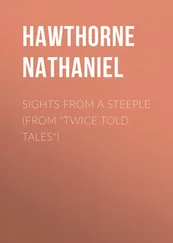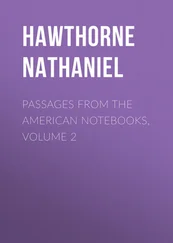Nathaniel Hawthorne - Passages from the French and Italian Notebooks, Volume 2
Здесь есть возможность читать онлайн «Nathaniel Hawthorne - Passages from the French and Italian Notebooks, Volume 2» — ознакомительный отрывок электронной книги совершенно бесплатно, а после прочтения отрывка купить полную версию. В некоторых случаях можно слушать аудио, скачать через торрент в формате fb2 и присутствует краткое содержание. Жанр: literature_19, foreign_antique, foreign_prose, на английском языке. Описание произведения, (предисловие) а так же отзывы посетителей доступны на портале библиотеки ЛибКат.
- Название:Passages from the French and Italian Notebooks, Volume 2
- Автор:
- Жанр:
- Год:неизвестен
- ISBN:нет данных
- Рейтинг книги:3 / 5. Голосов: 1
-
Избранное:Добавить в избранное
- Отзывы:
-
Ваша оценка:
- 60
- 1
- 2
- 3
- 4
- 5
Passages from the French and Italian Notebooks, Volume 2: краткое содержание, описание и аннотация
Предлагаем к чтению аннотацию, описание, краткое содержание или предисловие (зависит от того, что написал сам автор книги «Passages from the French and Italian Notebooks, Volume 2»). Если вы не нашли необходимую информацию о книге — напишите в комментариях, мы постараемся отыскать её.
Passages from the French and Italian Notebooks, Volume 2 — читать онлайн ознакомительный отрывок
Ниже представлен текст книги, разбитый по страницам. Система сохранения места последней прочитанной страницы, позволяет с удобством читать онлайн бесплатно книгу «Passages from the French and Italian Notebooks, Volume 2», без необходимости каждый раз заново искать на чём Вы остановились. Поставьте закладку, и сможете в любой момент перейти на страницу, на которой закончили чтение.
Интервал:
Закладка:
After annihilating the poor visage, Powers showed us his two busts of Proserpine and Psyche, and continued his lecture by showing the truth to nature with which these are modelled. I freely acknowledge the fact; there is no sort of comparison to be made between the beauty, intelligence, feeling, and accuracy of representation in these two faces and in that of the Venus de' Medici. A light – the light of a soul proper to each individual character – seems to shine from the interior of the marble, and beam forth from the features, chiefly from the eyes. Still insisting upon the eye, and hitting the poor Venus another and another and still another blow on that unhappy feature, Mr. Powers turned up and turned inward and turned outward his own Titanic orb, – the biggest, by far, that ever I saw in mortal head, – and made us see and confess that there was nothing right in the Venus and everything right in Psyche and Proserpine. To say the truth, their marble eyes have life, and, placing yourself in the proper position towards them, you can meet their glances, and feel them mingle with your own. Powers is a great man, and also a tender and delicate one, massive and rude of surface as he looks; and it is rather absurd to feel how he impressed his auditor, for the time being, with his own evident idea that nobody else is worthy to touch marble. Mr. B – told me that Powers has had many difficulties on professional grounds, as I understood him, and with his brother artists. No wonder! He has said enough in my hearing to put him at swords' points with sculptors of every epoch and every degree between the two inclusive extremes of Phidias and Clark Mills.
He has a bust of the reigning Grand Duchess of Tuscany, who sat to him for it. The bust is that of a noble-looking lady; and Powers remarked that royal personages have a certain look that distinguishes them from other people, and is seen in individuals of no lower rank. They all have it; the Queen of England and Prince Albert have it; and so likewise has every other Royalty, although the possession of this kingly look implies nothing whatever as respects kingly and commanding qualities. He said that none of our public men, whatever authority they may have held, or for whatever length of time, possess this look, but he added afterwards that Washington had it. Commanders of armies sometimes have it, but not in the degree that royal personages do. It is, as well as I could make out Powers's idea, a certain coldness of demeanor, and especially of eye, that surrounds them with an atmosphere through which the electricity of human brotherhood cannot pass. From their youth upward they are taught to feel themselves apart from the rest of mankind, and this manner becomes a second nature to them in consequence, and as a safeguard to their conventional dignity. They put themselves under glass, as it were (the illustration is my own), so that, though you see them, and see them looking no more noble and dignified than other mortals, nor so much so as many, still they keep themselves within a sort of sanctity, and repel you by an invisible barrier. Even if they invite you with a show of warmth and hospitality, you cannot get through. I, too, recognize this look in the portraits of Washington; in him, a mild, benevolent coldness and apartness, but indicating that formality which seems to have been deeper in him than in any other mortal, and which built up an actual fortification between himself and human sympathy. I wish, for once, Washington could come out of his envelopment and show us what his real dimensions were.
Among other models of statues heretofore made, Powers showed us one of Melancholy, or rather of Contemplation, from Milton's "Penseroso"; a female figure with uplifted face and rapt look, "communing with the skies." It is very fine, and goes deeply into Milton's thought; but, as far as the outward form and action are concerned, I remember seeing a rude engraving in my childhood that probably suggested the idea. It was prefixed to a cheap American edition of Milton's poems, and was probably as familiar to Powers as to myself. It is very remarkable how difficult it seems to be to strike out a new attitude in sculpture; a new group, or a new single figure.
One piece of sculpture Powers exhibited, however, which was very exquisite, and such as I never saw before. Opening a desk, he took out something carefully enclosed between two layers of cotton-wool, on removing which there appeared a little baby's hand most delicately represented in the whitest marble; all the dimples where the knuckles were to be, all the creases in the plump flesh, every infantine wrinkle of the soft skin being lovingly recorded. "The critics condemn minute representation," said Powers; "but you may look at this through a microscope and see if it injures the general effect." Nature herself never made a prettier or truer little hand. It was the hand of his daughter, – "Luly's hand," Powers called it, – the same that gave my own such a frank and friendly grasp when I first met "Luly." The sculptor made it only for himself and his wife, but so many people, he said, had insisted on having a copy, that there are now forty scattered about the world. At sixty years, Luly ought to have her hand sculptured again, and give it to her grandchildren with the baby's hand of five months old. The baby-hand that had done nothing, and felt only its mother's kiss; the old lady's hand that had exchanged the love-pressure, worn the marriage-ring, closed dead eyes, – done a lifetime's work, in short. The sentiment is rather obvious, but true nevertheless.
Before we went away, Powers took us into a room apart – apparently the secretest room he had – and showed us some tools and machinery, all of his own contrivance and invention. "You see I am a bit of a Yankee," he observed.
This machinery is chiefly to facilitate the process of modelling his works, for – except in portrait-busts – he makes no clay model as other sculptors do, but models directly in the plaster; so that instead of being crumbled, like clay, the original model remains a permanent possession. He has also invented a certain open file, which is of great use in finishing the surface of the marble; and likewise a machine for making these files and for punching holes through iron, and he demonstrated its efficiency by punching a hole through an iron bar, with a force equivalent to ten thousand pounds, by the mere application of a part of his own weight. These inventions, he says, are his amusement, and the bent of his nature towards sculpture must indeed have been strong, to counteract, in an American, such a capacity for the contrivance of steam-engines..
I had no idea of filling so many pages of this journal with the sayings and characteristics of Mr. Powers, but the man and his talk are fresh, original, and full of bone and muscle, and I enjoy him much.
We now proceeded to the Pitti Palace, and spent several hours pleasantly in its saloons of pictures. I never enjoyed pictures anywhere else as I do in Florence. There is an admirable Judith in this gallery by Allori; a face of great beauty and depth, and her hand clutches the head of Holofernes by the hair in a way that startles the spectator. There are two peasant Madonnas by Murillo; simple women, yet with a thoughtful sense of some high mystery connected with the baby in their arms.
Raphael grows upon me; several other famous painters – Guido, for instance – are fading out of my mind. Salvator Rosa has two really wonderful landscapes, looking from the shore seaward; and Rubens too, likewise on a large scale, of mountain and plain. It is very idle and foolish to talk of pictures; yet, after poring over them and into them, it seems a pity to let all the thought excited by them pass into nothingness.
The copyists of pictures are very numerous, both in the Pitti and Uffizi galleries; and, unlike sculptors, they appear to be on the best of terms with one another, chatting sociably, exchanging friendly criticism, and giving their opinions as to the best mode of attaining the desired effects. Perhaps, as mere copyists, they escape the jealousy that might spring up between rival painters attempting to develop original ideas. Miss Howorth says that the business of copying pictures, especially those of Raphael, is a regular profession, and she thinks it exceedingly obstructive to the progress or existence of a modern school of painting, there being a regular demand and sure sale for all copies of the old masters, at prices proportioned to their merit; whereas the effort to be original insures nothing, except long neglect, at the beginning of a career, and probably ultimate failure, and the necessity of becoming a copyist at last. Some artists employ themselves from youth to age in nothing else but the copying of one single and selfsame picture by Raphael, and grow at last to be perfectly mechanical, making, I suppose, the same identical stroke of the brush in fifty successive pictures.
Читать дальшеИнтервал:
Закладка:
Похожие книги на «Passages from the French and Italian Notebooks, Volume 2»
Представляем Вашему вниманию похожие книги на «Passages from the French and Italian Notebooks, Volume 2» списком для выбора. Мы отобрали схожую по названию и смыслу литературу в надежде предоставить читателям больше вариантов отыскать новые, интересные, ещё непрочитанные произведения.
Обсуждение, отзывы о книге «Passages from the French and Italian Notebooks, Volume 2» и просто собственные мнения читателей. Оставьте ваши комментарии, напишите, что Вы думаете о произведении, его смысле или главных героях. Укажите что конкретно понравилось, а что нет, и почему Вы так считаете.












